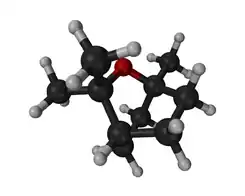Aceite de eucalipto
El aceite de eucalipto se obtiene de las hojas de las diversas especies de eucalipto. Su principal compuesto es el eucaliptol (1,8-cineol).[2]
| Eucaliptol | ||
|---|---|---|
 | ||
 | ||
 | ||
| Nombre IUPAC | ||
| 1,3,3-Trimetil-2-oxabiciclo[2,2,2]octano | ||
| General | ||
| Otros nombres |
1,8-cineol 1,8-epoxi-p-mentano | |
| Fórmula estructural |
 | |
| Fórmula molecular | C10H18O | |
| Identificadores | ||
| Número CAS | 470-82-6[1] | |
| ChEBI | 27961 | |
| ChEMBL | 485259 | |
| ChemSpider | 2656 | |
| DrugBank | DB03852 | |
| PubChem | 2758 | |
| UNII | RV6J6604TK | |
| KEGG | D04115 | |
|
O2C1(CCC(CC1)C2(C)C)C
| ||
| Propiedades físicas | ||
| Masa molar | 154.249 g/mol | |
| Punto de fusión | 274,6 K (1 °C) | |
| Punto de ebullición | 449 K (176 °C) | |
| Valores en el SI y en condiciones estándar (25 ℃ y 1 atm), salvo que se indique lo contrario. | ||
Se trata de un líquido miscible con alcohol, su olor varía entre el de la menta y el de la trementina. Se utiliza en perfumería, medicina y para la flotación de minerales. Se encuentra en muchos productos, ungüentos y linimentos, cremas para la pañalitis (dermatitis del pañal de los bebés), inhaladores para aliviar la congestión nasal, medicamentos para el dolor en encías, boca y garganta y enjuagues bucales.
Propiedades físico - químicas
Fórmula: C10H18O
Aspecto: Líquido transparente e incoloro.
Olor: Característico.
Punto de ebullición:177 °C
Punto de fusión: 1,5 °C
Punto de inflamación: 48 °C
Densidad (20/4): 0,924
Solubilidad: Inmiscible con agua y miscible en éter, etanol y cloroformo.
Toxicidad
La ingestión del aceite de eucalipto puede suponer un riesgo para la salud.[3]
Lista de plantas que contiene el compuesto
- Boldo
- Cannabis, cáñamo [4]
- Cinnamomum camphora, alcanforero, (50%)[5]
- Eucalyptus cneorifolia
- Eucalyptus dives,
- Eucalyptus dumosa
- Eucalyptus globulus[6]
- Eucalyptus goniocalyx
- Eucalyptus horistes
- Eucalyptus kochii
- Eucalyptus leucoxylon
- Eucalyptus oleosa
- Eucalyptus polybractea
- Eucalyptus radiata
- Eucalyptus sideroxylon
- Eucalyptus smithii
- Eucalyptus staigeriana[7]
- Eucalyptus tereticornis
- Eucalyptus viridis
- Helichrysum gymnocephalum[8]
- Kaempferia galanga, galanga, (5.7%)[9]
- Laurus nobilis, laurel, (45%)
- Melaleuca alternifolia, árbol del té, (0–15%)
- Prostanthera (Lamiaceae): numerosas especies.
- Salvia lavandulifolia, salvia española, salvia fina, (13%)[10]
- Turnera diffusa, damiana[11]
- Umbellularia californica, laurel de California, (22.0%)[12]
- "Vitex agnus castus", sauzgatillo
- Zingiber officinale, jengibre
- Lavander "lavanda"
Referencias
- Número CAS
- Dagli N1, Dagli R2, Mahmoud RS3, Baroudi K3 (2015 Sep-Oct). «Essential oils, their therapeutic properties, and implication in dentistry: A review». J Int Soc Prev Community Dent (Revisión) 5 (5): 335-40. PMC 4606594. PMID 26539382. doi:10.4103/2231-0762.165933.
- European Food Safety Authority (EFSA) (2012). «Compendium of botanicals reported to contain naturally occuring substances of possible concern for human health when used in food and food supplements». EFSA Journal 10 (5): 2663. doi:10.2903/j.efsa.2012.2663.
- McPartland J. M., Russo E. B (2001). «Cannabis and cannabis extracts: greater than the sum of their parts?». Journal of Cannabis Therapeutics 1 (3-4): 103-132. doi:10.1300/J175v01n03_08. Consultado el 20 de septiembre de 2013.
- Stubbs, B. J.; Brushett, D. (2001). «Leaf oil of Cinnamomum camphora (L.) Nees and Eberm. From Eastern Australia». Journal of Essential Oil Research 13 (1): 51-54. doi:10.1080/10412905.2001.9699604.
- Maciel, M. V.; Morais, S. M.; Bevilaqua, C. M.; Silva, R. A.; Barros, R. S.; Sousa, R. N.; Sousa, L. C.; Brito, E. S.; Souza-Neto M. A. (2010). «Chemical composition of Eucalyptus spp. essential oils and their insecticidal effects on Lutzomyia longipalpis». Veterinary Parasitology 167 (1): 1-7. PMID 19896276. doi:10.1016/j.vetpar.2009.09.053.
- Gilles, M.; Zhao, J.; An, M.; Agboola, S. (2010). «Chemical Composition and Antimicrobial Properties of Essential Oils of three Australian Eucalyptus Species». Food Chemistry 119 (2): 731-737. doi:10.1016/j.foodchem.2009.07.021.
- Möllenbeck, S.; König, T.; Schreier, P.; Schwab, W.; Rajaonarivony, J.; Ranarivelo, L. (1997). "Chemical Composition and Analyses of Enantiomers of Essential Oils from Madagascar". Flavour and Fragrance Journal 12 (2): 63. doi:10.1002/(SICI)1099-1026(199703)12:2<63::AID-FFJ614>3.0.CO;2-Z.
- Wong, K. C.; Ong, K. S.; Lim, C. L. (2006). «Composition of the Essential Oil of Rhizomes of Kaempferia Galanga L.». Flavour and Fragrance Journal 7 (5): 263-266. doi:10.1002/ffj.2730070506.
- Perry NS, Houghton PJ, Theobald A, Jenner P, Perry EK (2000). «In-vitro inhibition of human erythrocyte acetylcholinesterase by salvia lavandulaefolia essential oil and constituent terpenes». J Pharm Pharmacol 52 (7): 895-902. PMID 10933142. doi:10.1211/0022357001774598.
- Balch, P. A. (2002). Prescription for Nutritional Healing: the A to Z Guide to Supplements. Penguin. p. 233. ISBN 978-1-58333-143-9.
- Kelsey, R. G.; McCuistion, O.; Karchesy, J. (2007). «Bark and Leaf Essential Oil of Umbellularia californica, California Bay Laurel, from Oregon». Natural Product Communications 2 (7): 779-780.